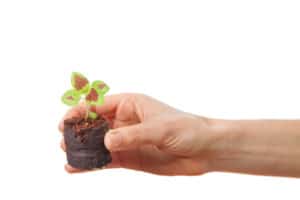Coleus plants come in various leaf sizes and overall shapes, with some of the most stunningly colored foliage, combining green, yellow, pink, and red shades. It doesn’t matter what kind you’re looking for, as you’re sure to find the perfect variety to add a specific color to your garden.
Next up, we’ve curated a step-by-step guide on how to grow top-notch coleus plants that will thrive even in cold environments!
| When Should I Plant Coleus? | Early Spring, as they’re sensitive to cold weather. Treat them as indoor plants and wait until temperatures reach 60°F to transplant them. |
| When Will The Seeds Germinate? | Eight to 12 weeks before the last yearly frost. Seeds usually take up to twenty days to germinate. |
| How Long Does It Take To Grow? | Three to four weeks. |
| Perennial or Annual? | Tender perennial |
How To Grow Coleus Seeds
You’re sure to achieve the most vibrant colors by exposing your coleus to morning sun and afternoon shade. As you might already know, although there are different varieties for different light conditions, too much shade will eventually cause weak and spindly plants.
You can propagate the plant directly from cuttings; they’ll need light and warmth to germinate. We recommend sowing seeds on top of a moist seed-starting mix before pressing them gently into the soil. Then, place the pots on a heating pad or near a sunny window to keep them between 70ºF and 75ºF, as coleus thrives in warm weather. Once your plants evolve into two real leaves, you can transplant them to larger containers and pinch them right above all branching junctions to shape and stimulate growth.
It’s crucial to keep them compact, so cut them back once they begin to bloom. Leftover flowers deplete the energy of the plant. You can also grow coleus outside, but remember to transplant them only past the danger of frost while the nighttime temperature is in the high 50°F to 60°F.
Step-By-Step Guide
Although germination can take up to twenty days, growing healthy coleus plants isn’t challenging. This plant might be a perfect choice if you’ve recently started gardening. Further below, we’ve listed some straightforward steps for you to follow.
- Choose large seed trays filled with a rich potting mix and place three to four seeds in the soil.
- Considering coleus needs both light and warmth to germinate, keeping the soil moist and the pots’ temperature at 70°F to 75°F is crucial. Keep the seeds indoors until a few leaves start to show.
- Transplant them into separate pots once the seedlings start to evolve.
- A week before moving them outdoors, gradually expose the growing seedlings to the outside environment to harden them.
- Locate an area where your coleus will receive light and shade in equal amounts and place the pot. Don’t forget to water the plant immediately.
Caring and Harvesting Coleus Plants
Caring for growing coleus is just as easy as planting them. First, keeping them moist is crucial; if you’re planting them indoors, you must water them more frequently.
Although optional, you can give the plants a boost of half-strength liquid fertilizer during their active blossoming in warm temperatures. Moreover, you can pinch the shoots to produce a bushier growth or cut the spiked flowers.
Remember, coleus are highly susceptible to cold, and you must be cautious with its exposure to frost by digging the plant up, potting it, and keeping it indoors through winter. Although your coleus might be in danger once the temperatures drop, you can always harvest the seeds for the following year.
Collect the seeds from your healthiest plant and wait for the flowers to come out before the fall. This time, don’t remove them: the seed pods will wither and eventually dry out. Once they turn brown, it’s time to harvest! You can now snip the pods with clean scissors and keep them in a cool, dry area, ensuring the seeds aren’t sticking to the flowers. A week later, they will be ready for storage. Then, you’ll need to wait for the temperatures to rise again.
You’ll manage to achieve healthy growth if you prune your coleus in summer and spring while the plant is growing. It’s crucial to cut it back only when it reaches full maturity and is about six inches tall.
Once you’ve pruned it for the first time, you can continue to do it as often as you deem necessary. Keeping tabs on your plant’s growth will help determine when it’s time to cut again. For example, if your coleus seems uneven or is starting to overgrow its container, you should give it a prune.
How to Prune Coleus
After determining which areas of the coleus you’ll keep and which you’ll cut back, pick up a clean pair of gardening shears and remove stems and leaves. Be careful with over-pruning, as it might end up looking leggy!
We recommend trimming it regularly to create bushier growth, even if your plant doesn’t need a complete prune. As stated earlier, pinching right above the nodes will help branches grow healthier leaves. If you’re planning to harvest seeds from your coleus, you should avoid pruning the flowers, which consume lots of energy from the plant.
Over-pruning coleus is an easy mistake that will make your plant look scrawny and demand more energy to grow everything back. Although it might not seem like a problem during summer when the plant is at its peak, it can be a more difficult challenge to overcome as the temperature drops.
It’s possible to cut back as much as a third of the plant’s full height, but if you plan for your coleus to survive the winter, keep in mind that the plant will not regrow as much during the frost, so you should avoid pruning unnecessarily to keep it healthy.
Choosing A Coleus Variety
Coleus plants work perfectly in many environments, embellishing your garden and bringing in that touch of color you might need in your home. There are over a thousand coleus varieties available, and each has exquisite foliage and a characteristic combination of leaf patterns. Next up, we’ve listed some of our favorite varieties!
- Black Dragon: Measuring around 12 inches, this variety has beautiful dark, purple ruffled leaves.
- Henna: This 24-inches variety has zigzagged leaves in gold and burgundy hues nearing the edges.
- Wizard Rose: This variety has bright green leaves with pinkish centers surrounded by white. It’s an undersized variety and won’t grow past 14 inches.
- Wasabi: This variety stays true to its name with its bright green leaves. It can grow as tall as 30 inches.
- Campfire: With pointy, serrated leaves, this variety can measure up to 20 inches in height. It’s well-known for its orange-red colored foliage, similar to rust.
- French Quarter: Combining a green edge with a bright pink center that fades into burgundy, this variety grows up to 30 inches, and its leaves are among the biggest.
- Electric Lime: This variety can grow up to 24 inches and has characteristic medium-green leaves with yellowish veins running through them.
Want to learn even more about this amazing plant? Check out our complete guide to coleus here.
Up Next:
- Is Coleus A Perennial Or Annual?
- Coleus Plant Indoors: How to Successfully Grow Coleus in a Pot
- When to Plant Coleus by Zone
- How to Propagate Coleus From Seed or Cuttings (With Amazing Results Every Time!)
The photo featured at the top of this post is © marekuliasz/Shutterstock.com
Sources
- Gardening Know-How, Available here: https://www.gardeningknowhow.com/ornamental/foliage/coleus/coleus-plant-care.htm
- SD State, Available here: https://extension.sdstate.edu/coleus-color-every-garden
- UC Master Gardeners, Available here: https://ucanr.edu/blogs/blogcore/postdetail.cfm?postnum=28449#:~:text=Coleus%20seeds%20need%20light%20and,keep%20between%2070%C2%BAF%20and%2075%C2%BAF
- Krostrade, Available here: https://krostrade.com/blog/how-to-trim-coleus/
Thank you for reading! Have some feedback for us? Contact the AZ Animals editorial team.






